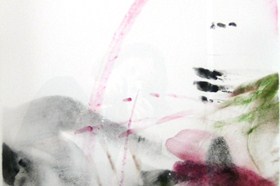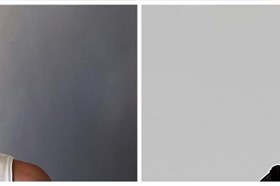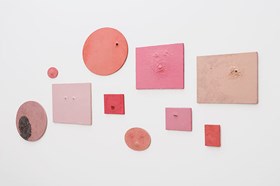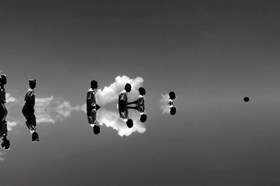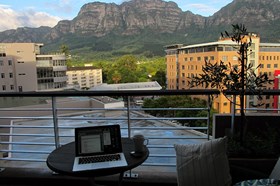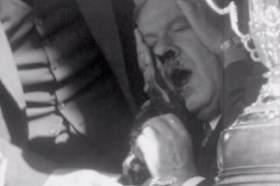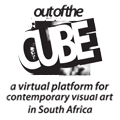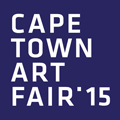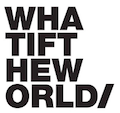cape reviews
Anyway the Wind Blows
Various Artists at Brundyn
By Lloyd Pollak04 December - 24 January. 0 Comment(s)

Jeannette Ehlers
Detail from: Black Bullets,
2012.
Single channel video
Duration: 5 min 05 sec (on loop).
It is rare for visitors to commercial art galleries to receive a welcome, let alone be graciously received by a divinity, but this is precisely what happens at Brundyn’s current exhibition 'Any Way, the Wind Blows'. You wander past the reception desk and – lo and behold – there perched upon a mahogany plinth, a rabbity, bronze Virgin Mary eagerly awaits you. With her long stiffened ears alert and ready as radar detectors to sense the current of our adoration, this is no tragic Michelangelesque mother gazing sorrowfully at her dead son. On the contrary, Sanell Aggenbach’s quadruped Madonna is all chutzpah and sass, and her attention is entirely focused upon the gallery-goers. Much as I hate to utter a critical word about our Lady, this Virgin is a born gold-digger who won’t hesitate to dump the corpse as soon as some more promising male hoves into view. The Messiah’s drooping body, like a deflated balloon, indicates a failure to rise again, and the roving-eyed Virgin appears deeply aggrieved by his perpetual tumescence.
art events calendar
VIEW FULL CALENDARbuy art prints
edition of 25: R3,500.00
About Editions for ArtThrob
Outstanding prints by top South African artists. Your chance to purchase SA art at affordable prices.
FIND OUT MORE Editions for artthrobThe concept of art as outrageous, tongue-in-cheek funsy-wunsy, also inspires Jody Paulsen’s Come As You Are (The Power of Moffies) a huge banner of flaming faggotry measuring 230 by 256 centimeters. As a form, banners embody both triumph and protest. They celebrate victory as they spearhead dissent, and Paulsen’s humorously militant Power of Moffies does both. It also alludes to that sacred icon of the Gay Liberation Movement, the Aid’s Quilt, and commemorates forgotten activists, such as Simon Nkoli. Executed in the touch-feely medium of felt, Come as you are is a pullulating mass of slogans, clenched fists, Aid’s ribbons, hammers, sickles, Yuletide bells and screaming mouths, open so wide, you can see the uvulas swinging to and fro like President Botha’s admonitory index finger. There is surely a debt to Cameron Platter who draws on the same lurid Day-Glo colors and pop sources – comics, retail flyers, logos, billboards and neon signage – to create similar pile-ups of flailing, hyperactive forms that compete for the viewer’s attention as aggressively as the stallholders at an Indian bazaar.
Jeannette Ehlers, an artist of Trinidadian and Danish origins, explores her Caribbean heritage by dealing with an episode in the history of the slave trade. Her video installation, Black Bullets, is a paean to insurgency, celebrating the Haitian Revolution of 1791 to 1804 when the slaves overthrew their masters, and broke out of their chains. The video – far and away the most potent work on the exhibition – occupies one entire wall of a huge cavernous gallery, and it fills the space with its elegiac lament. Ehlers handles history with poetic license, turning the event into a slow-motion pageant or march-past without a hint of conflict or violence. An endless row of air-born slaves slowly troop in single file across a cloudscape, and as they move from left to right, so they shrink in size until they finally disappear into a dot in the sky. The ceaseless flow of vanishing humanity commemorates generation upon generation of African slaves who died on foreign soil in the service of alien masters. What makes this compelling is the simplicity of the concept, and the doom-laden atmosphere generated by the minimalist sound track. Ominous sonic rumbles, like distant thunder, are punctuated by slow, solemn, rhythmic drumbeats that instill a sense of grim inexorability.

Sanell Aggenbach
Foxglove
2014
Oil on Canvas
42 x 116 cm
There is a delicious faux-naïf folksiness and charm to Ezra Wube’s video Hisab which captures all the tumult and clangor of Africa’s teeming cities. Hisab, a fantasy based on traditional Ethiopian lore, describes how dogs, goats and donkeys join commuters in travelling on Addis Ababa’s blue-and-white informal taxis, dutifully paying their fares, seating themselves, and behaving impeccably. The animation process used here is a seductive stop-action technique applied to the fluid medium of oil on glass, and it is the sheer painterly appeal of Wube’s dense, flowing impastos and deep African earth colors that make the video such a joy to watch.
Although there is much delight at 'Any Way the Wind Blows', one harbors reservations. You simply cannot juxtapose Jody Paulsen’s High Camp screaming queenery with Mohau Modisakeng’s sober black and white photographs. So low-key is his untitled triptych that Paulsen’s overpoweringly raucous blare completely upstages it, and similar acts of curatorial sabotage mar the impact of this show.
The visitors’ primary point of entry into any exhibition, is the gallery press release which, in this case, does the show a disservice. We are told that Ehlers’ video 'references stories of a Voodoo ceremony … wherein hundreds of slaves drank the blood of a sacrificed black pig to draw power for the approaching revolution,' however the video contains no allusion to a pig, a sacrifice or blood-drinking.

Jody Paulsen
Come As You Are (The Power of Moffies)
2014
Felt
230 x 256 cm
We are also informed that the exhibition is ‘conceptually framed around Barthes’ concept of myth’. Thereby many exhibits are forced into an exegetical straitjacket that simply does not fit. The Memento Mori painted by Aggenbach and Alex Emsley rely on analogy, and not myth, and works like Sidy Diallo’s Not for Sale are devoid of mythic content. Schoolboy howlers in the form of misspellings (‘vodou’ for ‘voudou’) diminish the writer’s credibility, and make one question whether he or she is capable of the deft cerebral jugglery which is a sine qua non when applying Barthes’ semiological theories to analyses of work of art. The document, written in art-speak of a mind-boggling opacity, bears this out. Apparently Richard Forbes’ steel sculpture Vortex 5 ‘looks at the idea of emptying reality into nothingness in a tangible sense, visualizing notions of void and absence as a sort of mythologizing taken to its absolute extremity.’ The only thing that is taken to its absolute extremity here is the patience of the reader, and the author’s matchless ability to write drivel. Despite these pratfalls, 'Any Way the Wind Blows' certainly deserves a visit.


